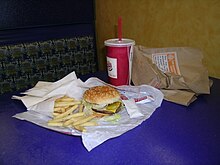Whopper

A Burger King Whopper sandwich
|
|
| Nutritional value per 1 sandwich (290 g) | |
|---|---|
| Energy | 650 kcal (2,700 kJ) |
|
50 g
|
|
| Sugars | 12 g |
| Dietary fiber | 2 g |
|
37 g
|
|
| Saturated | 11 g |
| Trans | 1.5 g |
|
22 g
|
|
| Minerals | |
| Sodium |
(61%)
910 mg |
| Other constituents | |
| Energy from fat | 340 kcal (1,400 kJ) |
| Cholesterol | 60 mg |
|
|
| Percentages are roughly approximated using US recommendations for adults. Source: www.BK.com (PDF) |
|

A meal including a Whopper, Jr., fries and a drink.
|
|
| Nutritional value per 1 sandwich (138 g) | |
|---|---|
| Energy | 300 kcal (1,300 kJ) |
|
27 g
|
|
| Sugars | 7 g |
| Dietary fiber | 1 g |
|
16 g
|
|
| Saturated | 4.5 g |
| Trans | 0.5 g |
|
9 g
|
|
| Minerals | |
| Sodium |
(31%)
460 mg |
| Other constituents | |
| Energy from fat | 150 kcal (630 kJ) |
| Cholesterol | 25 mg |
|
|
| Percentages are roughly approximated using US recommendations for adults. Source: www.BK.com (PDF) |
|
The Whopper is the main hamburger sold by the fast-food restaurant chain Burger King and its Australian franchise Hungry Jack's. Introduced in 1957, it has undergone several changes. The Whopper prompted competitors McDonald's and Wendy's to develop similar products. It is the focus of advertising, product tie-ins, and hoaxes. The company has registered global trademarks to protect the name.
The Whopper was created in 1957 by Burger King co-founder James McLamore and originally sold for 37¢ (equivalent to US$3.26 in 2017). McLamore created the burger after he noticed that a rival restaurant was having success selling a larger burger. Believing that the success of the rival product was its size, he devised the Whopper, naming it so because he thought it conveyed "imagery of something big". Major fast food chains did not release a similar product until the McDonald's Quarter Pounder and the Burger Chef Big Shef in the early 1970s.
Initially the sandwich was made with a plain bun; however, that changed when the company switched to a sesame-seeded bun around 1970. In 1985, the weight of the Whopper was increased to 4.2 oz (120 g), while the bun was replaced by a Kaiser roll. This was part of a program to improve the product and featured a US$30 million (approx US$66 million in 2014) advertising campaign featuring various celebrities such as Mr. T and Loretta Swit. The goal of the program was to help differentiate the company and its products from those of its competitors. The Whopper reverted to its previous size in 1987 when a new management team took over the company and reverted many of the changes initiated prior to 1985. The Whopper sandwich's Kaiser roll was changed back into a sesame seed bun in 1994, eliminating the last trace of the sandwich's 1985 reconfiguration.
The packaging has undergone many changes since its inception. Unlike McDonald's, the company never used the clamshell style box made of Styrofoam, so when the environmental concerns over Styrofoam came to a head in the late 1980s, the company was able to tout its use of paperboard boxes for its sandwiches. To cut back on the amount of paper that the company used, the paperboard box was fully eliminated in 1991 and was replaced with waxed paper. For a short time in 2002, the company used a gold-toned, aluminum foil wrapping for the sandwich as part of the 45th anniversary of the sandwich. The packaging was changed again in 2012 when the company moved to half wrapped sandwich packaged in a paper board box.
...
Wikipedia
